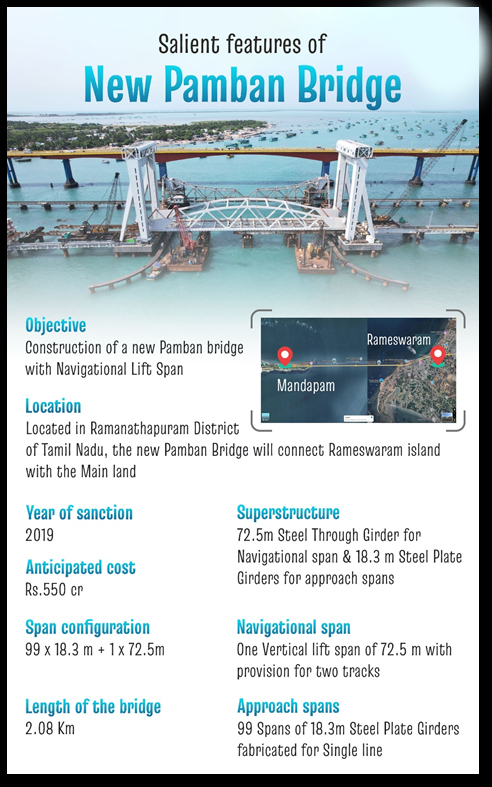Context:
Prime Minister Narendra Modi recently inaugurated the New Pamban Bridge in Tamil Nadu India marking a new landmark in infrastructure development in India. As the country’s first vertical-lift sea bridge, this state-of-the-art structure showcases India's advancing engineering capabilities and commitment to modernizing transportation.
Structural and Engineering Features
· Stretching 2.07 kilometers across the Palk Strait, the bridge links Rameswaram Island to mainland India.
· It replaces the original Pamban Bridge, constructed in 1914 by British engineers, which served as a crucial rail link but faced increasing challenges due to the harsh marine environment and growing transportation demands.
· The new bridge stands three meters taller than the original, ensuring better maritime clearance and smooth passage for ships.
· Built by Rail Vikas Nigam Limited (RVNL), a Navratna PSU under the Ministry of Railways, the bridge was sanctioned in 2019 with a focus on durability, speed, load-bearing capacity, and safety.
· A key highlight of the structure is its vertical-lift mechanism, which allows it to rise when required, enabling uninterrupted maritime traffic while ensuring railway connectivity.
Economic, Cultural, and Strategic Significance
Beyond its impressive engineering, the New Pamban Bridge is a lifeline for pilgrims, tourists, and trade, significantly improving connectivity and boosting the local economy.
The vertical-lift design ensures efficient maritime operations, supporting commercial and defense movements in the strategically important Palk Strait region.
Global Comparisons
The New Pamban Bridge joins an elite list of iconic bridges known for their engineering excellence, including:
- Golden Gate Bridge (USA) – a landmark suspension bridge.
- Tower Bridge (London) – a bascule and suspension bridge.
- resund Bridge (Denmark-Sweden) – a combined railway and motorway bridge.
Conclusion:
The New Pamban Bridge is more than just an infrastructural upgrade—it is a symbol of India’s progress, innovation, and engineering prowess. By blending modern technology with historical significance, this project reflects the nation’s vision for efficient, future-ready transportation while reinforcing its global position in infrastructure development.









